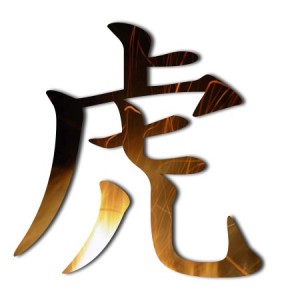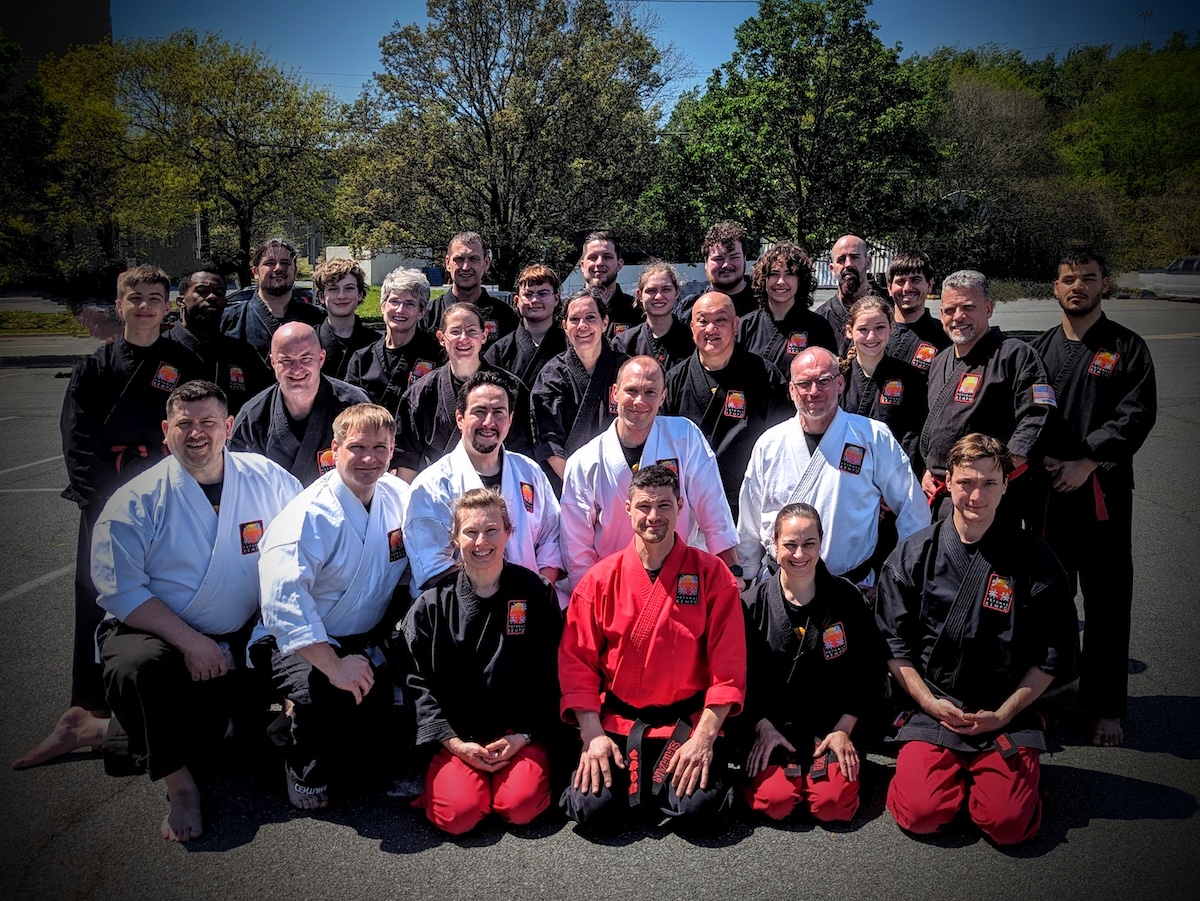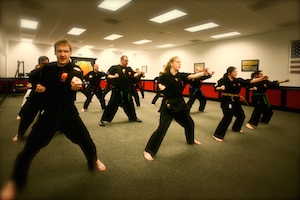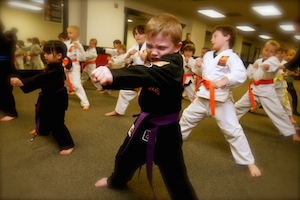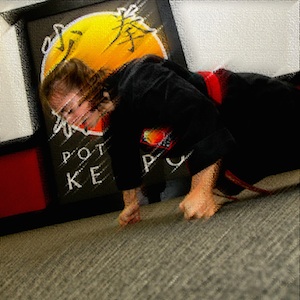For millennia the Tiger has been a powerful symbol in China, Buddhism, and in Shaolin specifically. Tiger statues have been unearthed that date to more than 7000 years ago, showing just how long the Tiger has been of interest. So ingrained is the Tiger in Chinese culture that the character for ‘king’ matches the markings on the forehead of a Tiger — a vertical line crossed with three horizontal lines. It is perhaps unknowable at this point if the symbol means ‘king’ because of the markings, or if the Tiger is so well regarded because it has the word ‘king’ on its forehead.
The Tiger in Buddhism
Perhaps the best example of reverence for the Tiger in Buddhist tradition comes in the form of a Jataka called “Tagmo Lujin.” Jatakas are stories of the previous lives of the Buddha and are instructive texts that depict his journey towards enlightenment. In this story Buddha and his companions find a Tigress who is so weak and hungry that she is about to eat her own cubs. His companions leave to find food for the Tigress but the Buddha realizes they will not return in time. He lays himself down so that the Tigress might feast upon his flesh, but she is too weak to even bite him. To help, he stabs his own neck with a stick that she might lap up his blood. In this way the Buddha gave his earthly body to save the life of a Tigress and her cubs. He was thereafter reborn into a better life for his sacrifice.
The Tiger in Shaolin
The Tiger was long ago chosen as one of the Five Shaolin animals, and the strongest of them. Moreover, according to legend, graduation from the Temple required moving a cauldron of smoldering incense with your forearms. After doing so your forearms were forever branded with the symbols of the Dragon and the Tiger. The Dragon represented the heights of spiritual understanding that you had reached and the Tiger represented physical prowess that no one else could boast of. The Tiger is synonymous with incredible strength, stamina, courage and power.
Aggressive Attack
The Tiger is the most aggressive of the animals, always opting for a direct approach. He eschews defense, strategy, and even blocking. In his purest form he will never retreat, only advance unceasingly. He will attempt to smother an attack but will seldom deign to block it.
An old saying tells us that “When two tigers meet one is dead, the other dying.” If two Tigers fight each other the conflict will be fierce and brief; it will certainly end tragically for one of them, and may end tragically for both.
The Crane will attempt to evade and maintain distance from the Tiger, but the Tiger’s directness and fierceness will overcome this maneuver. Sijo Trevor Haines writes that, “Most assaults are textbook examples of the Tiger and Crane relationship. The bad guy surprises and attacks his victim. The victim usually does not launch a counter attack but becomes defensive and retreats. The oncoming momentum of the attacking Tiger overcomes the victim who has unwittingly adopted a Crane mind set.” It should be noted that there is nothing intrinsically evil about using a Tiger fighting style, as suggested by the term ‘bad guy’ in the quote above. The ethical character of the assailants is understood from their motives, not the fighting style that they adopt.
Despite, and in some ways because of, the power and aggressiveness of the Tiger’s attack, he is vulnerable to the Dragon. The Dragon will evade and redirect this wall of energy and position herself off of the Tiger’s flank where he is vulnerable. A poorly trained, or untrained, Tiger will engage with powerful but unbalanced attacks — the ‘haymaker’ that we associate with unskilled brawlers, for instance. This will create an easy opening for the Dragon. However, even a skilled Tiger, using balanced attacks and proper posture, will definitionally commit himself enough to create an opening for an equally skilled Dragon.
Striking and Blocking
The Tiger utilizes a relatively modest arsenal of weapons, but what truly characterizes a “Tiger” attack is not the type of fist being used, but rather the nature of the energy behind the attack. This is perhaps more true of the Tiger than of any other animal. The energy is one of power, commitment and follow-through.
The Tiger favors the closed fist because of its aggressive character, but also utilizes the Tiger-claw and Tiger-mouth. The Tiger-claw and the Tiger-mouth will extend and strike before the fingers close on the opponent. This is often misunderstood even by people who have watched videos of Tigers attacking, since they do it so quickly. The Tiger pounces at its prey with extended arms, strikes and then holds on with its claws as the rest of its body follows. The Tiger does not pull its prey in with its claws — their flesh would tear under the strain — the Tiger simply uses the grip to hold his prey still for the moment it takes to close distance.
As such the Tiger will use Tiger-claws to the face, grabbing the ear; or as blocks, then grabbing the wrist; or to the groin, then grabbing the groin. Likewise Tiger-mouths will be used to the throat, which will not be released until the conflict has ended.
The Tiger will use kicks, but sparingly. In particular they will use low kicks, either to the knees or to the center of mass. The kicks to the center of mass are intended to stop the opponent in his tracks so the Tiger may charge forward. He will also use a very tight rising roundhouse kick, generally to the groin, upper leg, or floating ribs. Lastly, some Tiger stylists use a Tiger Tail Kick in which the practitioner kicks back from a kneeling position.
Fighting Style
The fighting style of the Tiger — or the strategy of “no strategy”— is the easiest to understand and may seem to be the easiest to implement. It is not, however, easy to implement. To attack as a Tiger, one must be two things: as physically strong as a Tiger; and as aggressive, courageous, and focused as a Tiger. To be as strong as the Tiger is hard to achieve, but critical. Very seldom does it behoove a smaller person to fight as a Tiger. In fact, such a situation often ends badly. So first one must strengthen their body so that they may power through their opponent in a significant way.
To be as aggressive, courageous, and focused as the Tiger is harder to understand and to accomplish. For Tiger techniques to be successful they have to be executed — not surprisingly — in the way a Tiger would execute them. That is to say, they have to be executed with the same aggression, courage and focus that one would observe in a Tiger. If you are going to forgo blocking, you have to be accepting of getting hit — and not faltering when you do. If you are going to power forward aggressively you cannot be fearful for your exposed flank — and not retreat when in that position. If you are going to stare down your opponent, there can be no fear behind your eyes.
Once imbued with the physical strength and mental fortitude of the Tiger, a martial artist is a formidable foe. He will strike directly for vulnerable areas, such as the face, groin and throat. If these areas are blocked he will strike through the block and continue onward. He will drive forward with his strikes, pressing off of the ground aggressively. Once he has closed distance he will drop his weight into the next round of strikes.
The Tiger also favors preemptive and stop techniques, striking forward as or before his opponent attacks. This can come in a number of forms, including a kick to the center of mass or a strike to the shoulder. These are particularly effective against slower circular attacks. Since the Tiger lacks the speed of the Leopard he will not be able to deploy these techniques in as many settings but when he does the effect will be devastating.
Lastly, it is interesting to note that the Tiger’s greater size and strength come at a cost. The Tiger, being bigger, will tire more quickly than other animals. His predilection for direct and efficient engagement is, in part, a byproduct of his inability to sustain his trademark level of tenacity for extended periods of time.
Physical Characteristics
To say that the Tiger is physically strong is to understate the facts. The Tiger has strong bones and muscles; he has powerful hands and legs. His core is well developed, allowing it to be an effective conduit for energy derived from the ground. In addition to strength he is well aligned, making sure that each strike is backed by a unified skeletal system.
He favors narrow stances, for their power potential and forward mobility. By doing so he limits his ability to move laterally, but considers this an acceptable tradeoff. While in such an uncompromising stance he will engage his opponent with a fierce glare. As he attacks forward he will proceed with a powerful ‘kiai’ born from his tense core and aggressive posture. This fierce glare and intense ‘kiai’ can startle or even scare an opponent, creating an opening that the Tiger can, and will, exploit.
Physical Training — Jing
Of the Three Treasures discussed in Traditional Chinese Medicine and Qi Gong, the trait the Tiger helps us to develop is our Jing — or Body. Having a well-developed Jing is more than simply being physically strong; it means having a body that is engaged and energized. Practicing Tiger techniques helps to develop our Jing by forcing us to align our bodies and commit through our strikes.
To do this effectively we need to begin by strengthening our core through planks, bridges, and variations of these, as well as low stances. From a strong core we move to developing strong legs. This is done through more low stances and various squatting exercises, with and without weights. Next, we develop strong arms and shoulders. This is done with pushups and the many variations of them.
Lastly, we develop commitment when striking and the resilience of our striking surfaces. The secret to these exercises is the variation in targets. By striking a wide variety of targets with vastly differing degrees of rigidity, we will develop the ability to commit through an attack regardless of the degree of resistance that we receive, while at the same time conditioning our striking surfaces to resist anything.
At one end of the spectrum we practice striking targets with almost infinite give, starting with a bucket of dry rice. This can be upgraded to buckets of beans, sand, and river stones when ready. Doing so will develop the striking surfaces, while at the same time practicing follow-through and commitment. We also need to practice striking targets with limited or no give. This begins with punching bags and will grow to include makiwara boards and, eventually, brick walls. Again this will train our striking surfaces and improve our power.
Mental Characteristics
Courage is defined, quite simply, as the ability to act despite fear. Fear can be triggered by many things, perhaps most commonly by the unknowable nature of the future. We may fear a situation because of the possibility of injury or loss, but we may also fear it because of the uncertainty it represents. The Tiger encourages us to meet all of those situations without breaking stride; he gives us strength when we are slowed by fear. Importantly, for all Kempo practitioners, as well as all people, he gives us courage to live our lives with integrity regardless of the situation.
Tenacity is related to courage but not to fear. Tenacity is the tendency to approach things with vigor and in a determined way. Just as the Tiger strikes forward and through an opponent’s blocks he will also approach all situations in life with commitment and drive. Confronting projects with tenacity generates momentum and follow-through almost as a matter of course. A tenacious approach also tends to forestall the beginnings of fear, where they might otherwise have taken grip.
These two characteristics alone tend to lead to great accomplishment and success. When coupled with the Tiger’s strength and physical prowess the result is an animal that is very sure of its place in the world. People who are very sure of their place in the world are also very humble. As the Tiger looks around, he views himself and others with respect and treats everyone with the esteem that they deserve. Humility also helps us to ‘empty our cup’ so that we might learn more. One might be familiar with the expression, “As an empty cup can be readily filled, an open mind is sure to learn.”
Power Through
The essence of the Tiger is captured in the idea, “Power Through.” We see this in the discussion of the Tiger’s fighting style as well as in his mental characteristics. When confronted with an obstacle of any kind, the Tiger will power through the situation regardless of the cost or risk. When confronted with an obstacle he will sink into his stance — figuratively or literally — and say, “Bring it.”
Miyamoto Musashi, the renowned Samurai, personified the Tiger. He advised to, “Always maintain the attitude of defeating your enemy with one strike.” That said, the Tiger’s way is not the only way, and not always the right way. We, as practitioners, can choose amongst all of the animals when responding to life’s challenges. Choosing to be the Tiger against a larger or stronger opponent will end badly, just as trying to power through a situation in which you lack sufficient advantage will also end badly. Despite the allure of the the Tiger’s persona, it is sometimes best to adopt the character of another animal.
In Summary
The Tiger is an amazing creature, particularly when we look at his physical traits. What is interesting, then, is that for most people he is more instructive in the context of his mental traits. Consider that the Tiger’s fighting tactics work best for people who are physically larger and stronger than their opponents. This means that a Tiger’s fighting tactics make sense for a distinct minority of the population. However, the mental strengths that we learn from the Tiger can work for everyone every day.
With the courage and tenacity that we learn from the Tiger we can power through life and be successful in all of the areas that matter to us. With the humility that we learn from the Tiger we can take that success in stride and be very comfortable with our place in the world.
